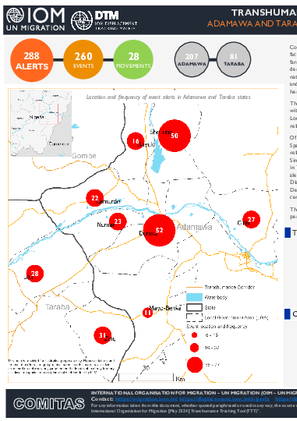-
Countries
-
Data and Analysis
-
Special Focus
-
Crisis Responses
Nigeria — Transhumance Tracking Tool Report — Early Warning Dashboard 24 — Adamawa and Taraba states (April 2024)

Contact
DTM Nigeria, iomnigeriadtm@iom.int
Language
English
Location
Nigeria
Period Covered
Apr 01 2024
Apr 30 2024
Activity
- Other
Conflicts between farmers and herders in North-East Nigeria and other Sahel regions are rooted in many factors such as desertification, climate change impacts, low rainfall, and competition over suitable land for farming and transhumance activities. These issues are exacerbated by rapid population growth, which drives demand for food, shelter, and security for both humans and livestock. Consequently, competition for scarce natural resources intensifies, leading to incidents like farming on cattle routes, crop destruction, farm damage, and water pollution among others, which often escalate into violent confrontations between the farmer and herder communities.
The Transhumance Tracking Tool (TTT) as a component of the IOM's Displacement Tracking Matrix (DTM), with the support of community key informants, operationalized the Early Warning System in the selected 9 Local Government Area (LGA) in the adjoining states of Adamawa and Taraba to collect alerts that are related to farmer-herder conflicts.
Of the 288 alerts recorded in April, 260 (90%) are event-related while 28 (10%) are related to movements. Specifically, Demsa, Girei, Lamurde, Numan and Shelleng LGAs in Adamawa state reported solely event-related alerts, while in Guyuk LGA, 89 per cent were event-related and 11 per cent were movement-related. Similarly, Mayo-belwa LGA reported 73 per cent event-related alerts and 27 per cent movement-related. Also in Taraba state, Lau LGA reported 74 per cent of event-related alerts and 26 per cent are movement-related alerts while Zing LGA reported 72 per cent of movement-related alerts and 28 per cent are event-related. Disaggregated ward-level data indicates that Kodompti, Talum and Demsa wards in Numan, Shelleng and Demsa LGAs of Adamawa state reported the highest percentage of events, cumulatively encompassing 20 per cent of the total alerts.
The event alerts reported across all LGAs suggested a population displacement rate of 2 per cent, with 17 per cent of instances of alerts resulting in casualties or injuries.
